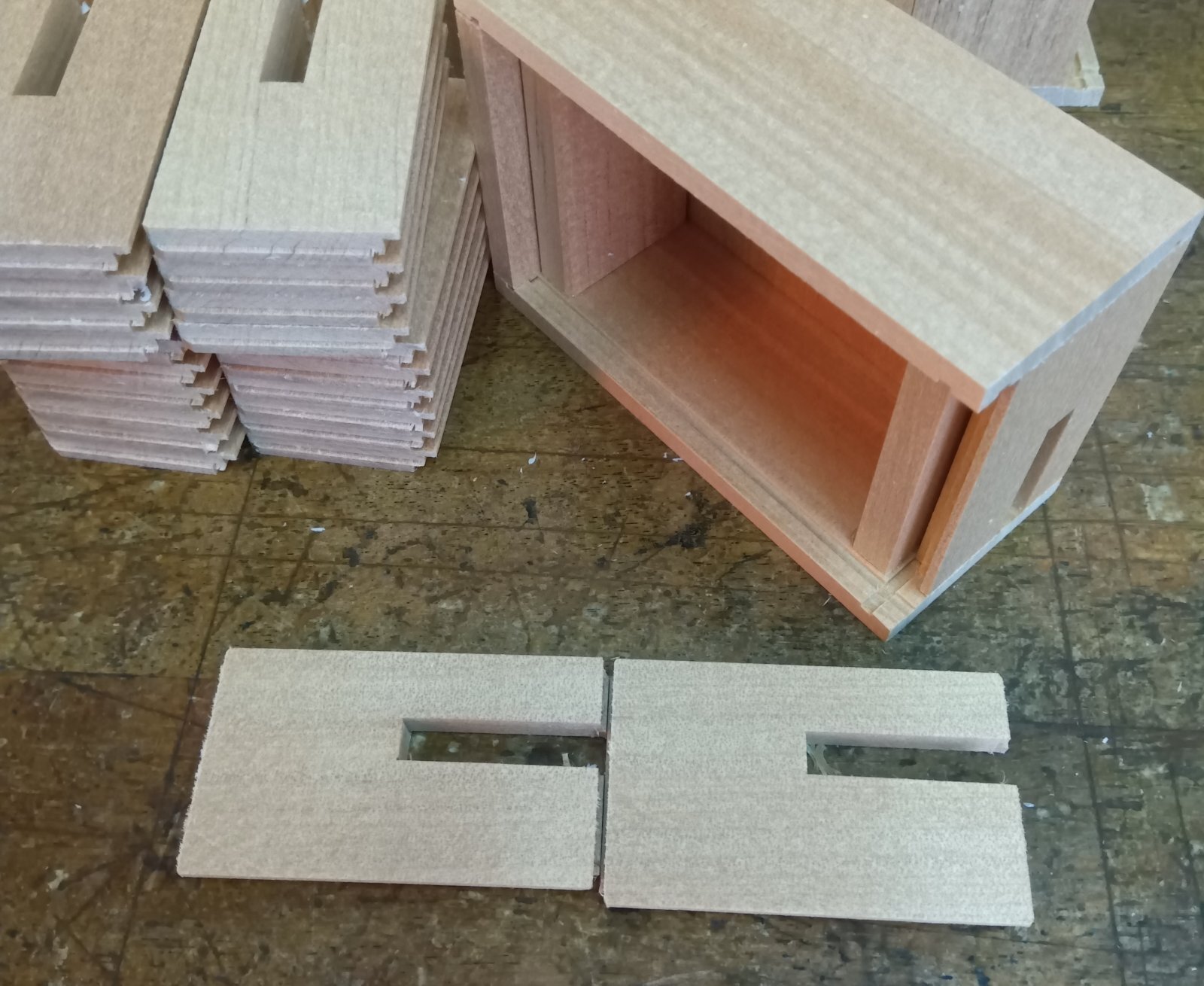18-steps aruki panels
Today, I was torn between working on the finishing process for the 2.5-sun box or making the Aruki panels (moving panels) for the 18-step box. In the end, I decided to focus on the 4-sun 18-step version.
Starting in the morning, I began processing the Aruki panels, which had already been shaved down to the standard thickness. For the 18-step box, the Aruki panel thickness is 6.5mm, which is the same as for 12-step and 14-step boxes. I never use thinner Aruki panels for 4-sun boxes, so in that sense... this type of Aruki panel is quite comfortable to work with.
However, the 18-step mechanism is made by adding a small adjustment to the standard 14-step mechanism so that the bottom panel also moves. One major feature of the 18-step box is that—unlike the 21-step, 27-step, or 36-step boxes where all four sides move—it starts from the opposite side compared to the usual opening sequence.
Normally (if we can call it "normal"), the box begins to open with the Aruki panel that comes just before the lid panel. That means the order of operation is:
Kannuki → Aruki panel #1 → Lid panel.
But with the 18-step version, the sequence usually starts with the second Aruki panel, followed by the bottom panel. This is a key feature that also affects how the box is constructed.
In a typical puzzle box, the left and right Aruki panels are made nearly the same, with one important difference: the length. The Aruki that moves first is made slightly shorter—about 2mm—than the other. This is because at the start, no other parts have moved yet, so the shorter length creates a small “gap” that gives the first Aruki panel room to move.
For 27-step boxes, this shorter Aruki is usually placed just before the top panel. But for the 18-step version, it must be installed just before the bottom panel. If you mistakenly install it near the top panel, like in a 27-step box, the 18-step mechanism won’t function correctly.
Since I usually build 27-step or 21-step boxes, I sometimes fall into the habit of placing it in the wrong spot. Actually, I’ve made this mistake a few times in the past 😅
I think only once did I complete the entire box without noticing the mistake—but unfortunately, those boxes had to be discarded 😭 In the other cases, I caught the error partway through and was able to redo the section.
This might sound like a very technical explanation and This may be a bit confusing, but it’s one of the key points I always remind myself of when making an 18-step box.
After that, I attached the mechanism and then glued on the top panel.
Since I’m making about 30 boxes this time, the pace of the work is moving along well. I’m excited to see how the new design will look once everything is finished 😄
Starting in the morning, I began processing the Aruki panels, which had already been shaved down to the standard thickness. For the 18-step box, the Aruki panel thickness is 6.5mm, which is the same as for 12-step and 14-step boxes. I never use thinner Aruki panels for 4-sun boxes, so in that sense... this type of Aruki panel is quite comfortable to work with.
However, the 18-step mechanism is made by adding a small adjustment to the standard 14-step mechanism so that the bottom panel also moves. One major feature of the 18-step box is that—unlike the 21-step, 27-step, or 36-step boxes where all four sides move—it starts from the opposite side compared to the usual opening sequence.
Normally (if we can call it "normal"), the box begins to open with the Aruki panel that comes just before the lid panel. That means the order of operation is:
Kannuki → Aruki panel #1 → Lid panel.
But with the 18-step version, the sequence usually starts with the second Aruki panel, followed by the bottom panel. This is a key feature that also affects how the box is constructed.
In a typical puzzle box, the left and right Aruki panels are made nearly the same, with one important difference: the length. The Aruki that moves first is made slightly shorter—about 2mm—than the other. This is because at the start, no other parts have moved yet, so the shorter length creates a small “gap” that gives the first Aruki panel room to move.
For 27-step boxes, this shorter Aruki is usually placed just before the top panel. But for the 18-step version, it must be installed just before the bottom panel. If you mistakenly install it near the top panel, like in a 27-step box, the 18-step mechanism won’t function correctly.
Since I usually build 27-step or 21-step boxes, I sometimes fall into the habit of placing it in the wrong spot. Actually, I’ve made this mistake a few times in the past 😅
I think only once did I complete the entire box without noticing the mistake—but unfortunately, those boxes had to be discarded 😭 In the other cases, I caught the error partway through and was able to redo the section.
This might sound like a very technical explanation and This may be a bit confusing, but it’s one of the key points I always remind myself of when making an 18-step box.
After that, I attached the mechanism and then glued on the top panel.
Since I’m making about 30 boxes this time, the pace of the work is moving along well. I’m excited to see how the new design will look once everything is finished 😄
